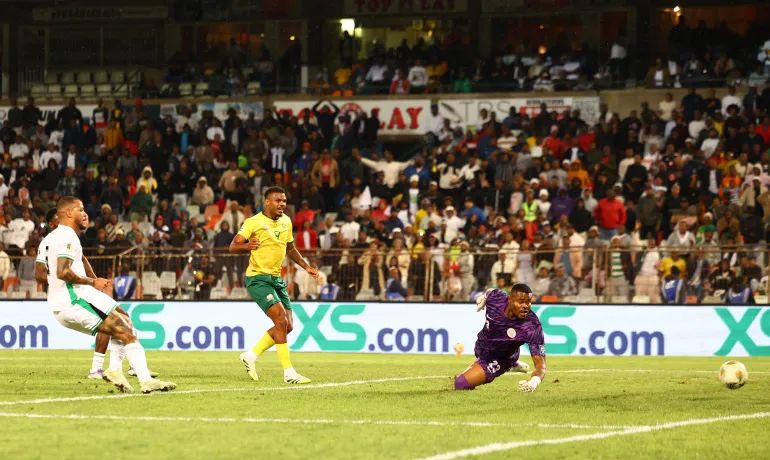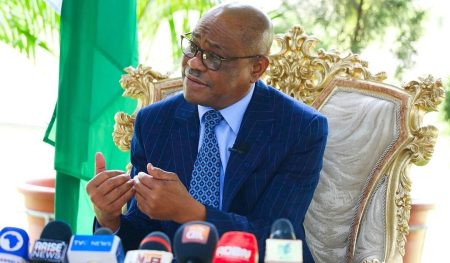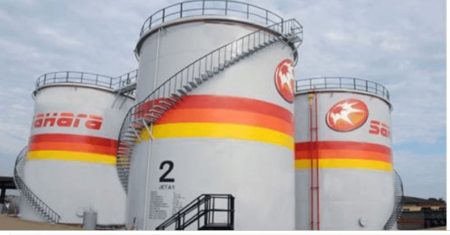The first half of the international friendly between Nigeria’s Super Eagles and South Africa’s Bafana Bafana at the Free State Stadium in Bloemfontein unfolded as a captivating back-and-forth affair, culminating in a 1-1 draw at the break. The match began with a palpable sense of urgency, particularly from the home side, South Africa, who sought to leverage their home advantage to seize early control of the game. Their initial efforts, however, were met with a resolute Nigerian defense, forcing them to resort to counter-attacking strategies. The opening exchanges witnessed a flurry of activity on both ends, with both teams vying for dominance in midfield and searching for opportunities to penetrate the opposing defenses.
South Africa’s early pressure manifested in concerted attempts to exploit the flanks, using their pace and width to stretch the Nigerian backline. This tactic yielded several promising advances, with speedy runs and crosses into the Nigerian penalty area. One such foray led to South Africa’s first real scoring opportunity, forcing a crucial save from the Nigerian goalkeeper, Nwabali. Nigeria, meanwhile, responded with quick transitions and attempted to utilize the creative prowess of Ademola Lookman, whose early cross resulted in their first corner of the match. While South Africa’s goalkeeper, Foster, confidently dealt with the resulting set-piece, the early exchanges underscored the attacking intent of both sides.
The intensity of the match ratcheted up as the first half progressed, leading to a series of fouls and a general increase in physicality. This period saw the referee brandishing yellow cards to Ngezana of South Africa and Lookman of Nigeria, highlighting the growing friction on the pitch. A significant blow to Nigeria came in the form of an injury to Ola Aina, who was forced to leave the field after a challenge. His replacement, Bright Osayi-Samuel, was immediately thrust into the action, adding fresh impetus to Nigeria’s attack down the right wing.
The breakthrough finally came for South Africa in the 24th minute, arriving somewhat fortuitously. A well-placed through ball from Mokoena found Nkota in a dangerous position on the flank. Nkota’s subsequent cross into the box was inadvertently deflected into his own net by Nigerian captain William Troost-Ekong, gifting South Africa the lead. This goal reflected South Africa’s dominance in the opening stages, where they enjoyed a greater share of possession and created more scoring opportunities.
Despite falling behind, Nigeria refused to be disheartened and continued to press forward with renewed determination. Osayi-Samuel’s introduction injected pace and directness into their attacks, although he was often met by a resilient South African defense. The match maintained its high-octane tempo, with both teams engaging in robust tackles and occasionally heated exchanges, requiring the referee’s intervention to maintain order. The momentum, however, began to shift subtly in Nigeria’s favor as they started to string together passes and exert more pressure in the South African half.
Nigeria’s persistence finally paid off just before halftime with a dramatic equalizer. A flowing move initiated by Lookman found Moses Simon on the right wing. Simon’s perfectly weighted cross into the box was met by Calvin Bassey, who headed the ball into the net. The goal sparked controversy, as replays hinted at a possible handball by Bassey. However, in the absence of VAR, the referee awarded the goal, restoring parity to the scoreline.
The final minutes of the first half saw both teams vying to regain the advantage, but neither could break through the opposing defense. Three minutes of added time were signaled by the referee, and the half concluded with the score tied at 1-1. The first half ended with the scores level, setting the stage for an intriguing second half. South Africa aimed to consolidate their position at the top of the group with a victory, while Nigeria hoped to secure a win that would propel them into second place.
The first 45 minutes showcased the contrasting styles of both teams. South Africa’s approach was characterized by quick transitions and exploiting spaces on the flanks, while Nigeria relied on individual brilliance and a more patient build-up play. The midfield battle proved crucial, with both teams vying for control. South Africa’s Mokoena played a pivotal role in their attacking moves, while Nigeria looked to Lookman and Simon for creative inspiration.
Defensively, both teams displayed resilience and organization, although the own goal by Troost-Ekong highlighted a moment of vulnerability in the Nigerian defense. South Africa’s defensive line stood strong against Nigeria’s attacking forays for much of the half, but they were ultimately unable to prevent the equalizer just before the break.
The first half provided an enthralling spectacle for the fans at the Free State Stadium and set the scene for a potentially decisive second half. With the scores level, both teams had everything to play for in the remaining 45 minutes. The match showcased the competitive spirit and talent within African football, with both sides displaying their desire to secure a victory.














